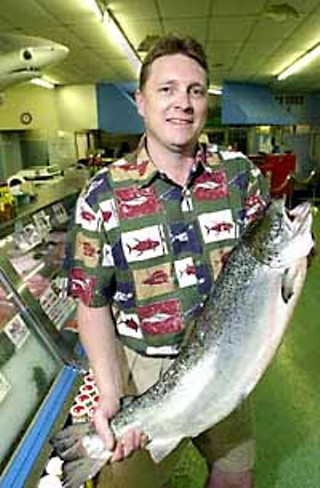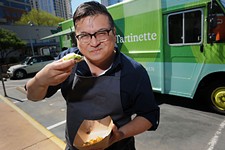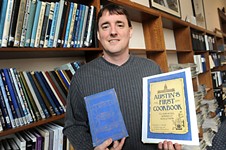Fish Tales
Eaves Bros. Quality Seafood, At the Sign of the Neon Lobster
By MM Pack, Fri., March 22, 2002

When you walk in the door at Eaves Bros. Quality Seafood, the first thing you notice is that it smells like the ocean. Your second thought might be that you've stumbled into some surreal fish-figured cartoon, where life-sized dolphins and sharks swim in the air above your head, and every available surface is painted with stylized blue waves and dancing day-glo sea creatures. The third observation is that everyone who works here is really busy.
This last isn't too surprising, considering that an astonishing 8,000 pounds of seafood arrive every day at this unassuming white building on Airport Boulevard, where it's efficiently processed for the retail fish market, the in-house restaurant, and the extensive wholesale operation that supplies fish to 180 Austin-area restaurants. If you eat out in this city, chances are you've tasted seafood from Eaves Bros. Quality Seafood.
Through several incarnations, Quality Seafood has been around in Austin for a long time. It all began in 1938, when Garnett Lenz and John Starr added fresh seafood to Starr's Fruit and Vegetable Market at 1005 Congress (just across from the Capitol, now the Bank of Texas Building). As the operation grew, it moved twice before landing in 1950 near the corner of Trinity and East 19th (now MLK). In 1957, Chester C. Husted bought the prospering retail business; it moved to the present Airport Boulevard location in 1970, where the seafood restaurant was added. In 1991, Harris Husted and his sister Jamie sold Quality Seafood to Sam Eaves, who combined it with his existing wholesale business, creating today's Eaves Bros. Quality Seafood -- fish market, restaurant, and booming wholesale operation.
Articulate and intense, Sam Eaves is passionate about fish, and his enthusiasm for the seafood business is infectious. He acquired his first fishing boat at 12, and he never looked back. "I started fishing commercially when I was growing up on the coast of southeast Alaska, known as the Banana Belt. My parents were missionaries from Texas to the Tlingits who lived on the coastal islands. Fishing was just about the only work there was, and that's what my three brothers and I did."
By 1984, Sam and his older brother Dexter had sold their boats and fishing licenses and moved to Austin to found Eaves Bros. Alaskan Seafood Inc., a wholesale import business. Dexter Eaves left the company in 1987 to attend law school; he's now the District Attorney in Victoria, Texas.
About the time Sam Eaves acquired Quality Seafood, the seafood business underwent a dramatic transformation; the American public's demand for fresh rather than frozen fish increased exponentially. As a result, the Food and Drug Administration developed the stringent HACCP (Hazard Analysis and Critical Control Point) standards for safe seafood storage and handling. Many establishments, having traditionally dealt with primarily frozen products, weren't able to comply with the new standards for fresh fish. Austin was no exception. In 1984, there were 24 wholesale seafood companies in town; today there are two, Eaves Bros. and Austin Seafood.
With HACCP standards well in hand, Eaves Bros. Quality Seafood continues to prosper; it was a $3.7 million business last year and has 15 full-time employees. As a longtime customer at the fish counter, I was surprised to learn that the wholesale operation constitutes a whopping 80% of the business. Although the market and the restaurant are always jumping, it seems that even more of the action takes place out back, behind the sea blue swinging doors.
Eaves Bros. Wholesale
In the compact office, the energetic Eaves, his wife Linda (the office manager), and General Manager Tom Cantu are constantly on the phone to suppliers around the world. They buy fish from about 15 regular sources in Ecuador, New Zealand, Iceland, Taiwan, Canada, Hawaii, South Africa, Fiji, and Vietnam, as well as from the three U.S. coasts. Eaves, who calls himself a fish-finder, says, "We fly product in seven days a week. Our two ice machines are going all the time, making 10,000 pounds of ice every day. And we need all of it."
Eaves is fanatical about delivering the freshest and highest quality fish to his customers and is committed to doing whatever it takes to make it happen. He explains that the seafood business is really a very small community, not just in the U.S., but across the planet. "Not only does everyone know everyone else, but everyone knows everyone's reputation. Success in this business all depends on your relationships with other fish people. There's only a certain amount of seafood to go around, and our goal is to get the absolute best."
I wonder how world-class seafood ends up in a smallish inland city like Austin. Eaves explains, "We're on every dealer's A-list because they know we pay our bills and we pay top price for top-load product. That means when we call with an order, we get the fish from the top of a boat's cargo, not from the bottom. And we buy only graded fish. In my mind, there are three approaches in this business: quality, service, and price. You have to decide which of these are the most important. I choose to focus on quality and service, and that has served us very well. Dealers know we are interested only in the best, and chefs know they can trust the seafood they buy from us."
Although Eaves does a brisk business in frozen and processed products such as squid, salt cod, and soft-shell crab, all the fresh fish is purchased whole. This means that it is all cut up in-house. There's a 24-hour turnaround rule -- all arriving fish is processed within 24 hours -- so you can imagine the hum of activity at the cutting tables.

Believe me, the guys in the back know their fish and their knifework. After watching them in action, I understand how so many pounds get processed so quickly every day. Wholesale Manager John Martinez has been cutting fish for 25 years. His brother-in-law, General Manager Tom Cantu, has worked at Quality Seafood for 42 years. That's right, since 1960. Supposedly retired five years ago, Cantu puts in half-days now, but he is still the only one who puts a knife to the most valuable tuna and swordfish.
I watched while Cantu broke down a three-foot-long, 100-pound-plus yellowfin tuna. In five minutes, he reduced the giant fish to a clean skeleton and four beautiful red loins worth about $700 wholesale. Only the skin, fins, and bones went into the waste can. (They fill up 12 bone barrels a day, about 2,500 pounds, which is recycled as fertilizer.) Across the cutting table, Rick DeLeon, who was pulling pin bones from about 30 sides of salmon, cracked, "Yeah, give him a couple more minutes and he could put it all back together."
This skill is taught to new employees (although there isn't much turnover); it's also shared with food professionals. About 10 times a year, they give demonstrations to Austin culinary students. In 2000, in conjunction with Austin's International Foodworks, a nonprofit food research organization that works with the USDA's Foreign Agricultural Service, Eaves and Cantu conducted a workshop and demonstration for seafood professionals from Poland who came here to learn about the American fish business.
The Fish Market
A quick survey of the fresh fish counter showed, among other things, two kinds of shrimp, king crab legs, fresh-cooked crawfish, picked blue crab, Florida stone crab, black drum, tuna, catfish filets, ready-to-cook stuffed crab, turbot, and wild Atlantic salmon. The freezer case contained everything from alligator to octopus. I learned that if customers want something that isn't displayed, they should ask; there are lots of other products in the back, and they're available on request. They will also special-order just about anything you might want.
Behind the counter, there's a good bit of Austin background going on. Twelve-year veteran Lee Chandler, the retail manager, previously worked at Whole Foods Market. Al Breitenbach is a third-generation native Austinite and former manager of Liberty Lunch. He remembers going as a child to the old Quality Seafood when it was on 19th Street. Before coming to work at the market, Michael O'Hara was a bartender at Liberty Lunch for 13 years. Eaves says, "We've got good guys on the counter, they know how to cut fish and they know how to cook it. If you want suggestions about cooking your seafood, just ask them."
Quality Seafood almost never advertises. According to Eaves, studies show that 2% of the U.S. population eats seafood once a week, and only .2% eats seafood more often than that. Since the retail market is so small, Eaves says it doesn't make sense to advertise to the general public. However, they've had great success with their customer e-mail list, set up and maintained by Breitenbach, who sends out announcements, coupons, and recipes every few days. Breitenbach says that there's a 90% response rate to the e-mails. "We're reaching the people who care about fish," he says.
Another successful campaign a few years ago was the popular Quality Seafood T-shirt designed by Greg Barton, who won an Addy award for it. The shirts proclaim, "Today you could kick every mud-crawling politician out of Congress and usher in an era of open, honest government ... Or, you could suck crawfish."
The Restaurant
The busy informal restaurant within Quality Seafood serves a lot of fish dinners all day long, many of them to people who probably wouldn't dream of putting filet to frying pan themselves.
I've observed that, at six in the evening, diners seem mostly to be solitary guys, enjoying their fish fixes at separate tables. Eaves agrees, "This is the kind of place where you don't have to be sociable if you don't feel like it." Lunchtime is a different story, however. The parking lot is full, the ordering line is long, and convivial groups of worker-friends overflow into the little auxiliary dining room down the hall.
"When we bought the retail operation in '91, we closed the restaurant part because I had no desire to be in the restaurant business," he laughs. "But we got so many complaints that we had to open it again. So James runs the restaurant the way he wants to, and I stay out of it."
Chef James Caldwell has been the resident kitchen talent for the past decade. Another Austin native, Caldwell learned to cook from his mother, and he's been cooking professionally since 1966, including 15 years at Chez Fred/Chez Zee. His fare at Quality Seafood is simple, generously portioned, inexpensive, and to-die-for good. You can just imagine how fresh the fish is.
The menu covers a variety of fried or broiled seafood dinners and fat Po'Boy sandwiches, accompanied by coleslaw, French fries, and wickedly tasty hushpuppies. There are seafood salads and dense Louisiana-style soups -- crawfish étouffée, gumbo, and shrimp Creole, along with a surprise special every day, depending on what's good in the back. The chef opines that the seafood gumbo is the biggest seller, with the fried oyster Po'Boy (my favorite) running a close second.
Caldwell is quick to emphasize that he couldn't manage without his tight longtime crew -- Beverly Wright, Adele Thornton, Paul Corley, and James' brother Willie Caldwell, who makes the desserts (alternating with his other job as a Baptist minister). "If we get too busy in the restaurant, the guys in the market help us out," he says. "They might mumble, but they're always right here if we need 'em. This is a nice place to work. We look out for each other.
"And tell people ... it's a good place to buy fish and a good place to come and eat."
So I'm telling you. I couldn't have said it better myself. ![]()








